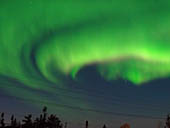 | Dispatch 1: Greetings from Kugluktuk!
Good afternoon from the coast of Kugluktuk, Nunavut Territory in northern Canada! The CCGS Louis S. St-Laurent, our home for the next 23 days, is at anchor 3km offshore, awaiting the arrival of a final contingent of people coming in from Yellowknife. Due to fog, the airport in Kugluktuk was closed on September 10th, our planned arrival date. Backed up travelers quickly snapped up all available rooms and we were lucky to get hotel rooms while we rearranged airline reservations |
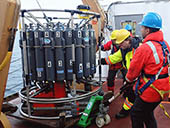 | Dispatch 2: First Science Day!
Good luck was with us today - Friday the 13th - as we successfully conducted science on our first full day aboard the icebreaker CCGS Louis S. St-Laurent. Since 6pm the previous day, the vessel has been steaming west and north towards the first of many stations that will be sampled for the 17th consecutive year. Having sailed on many oceanographic research vessels, this was the first icebreaker I have had the honor and privilege to sail on. The Amundsen Gulf at this time of year was free of sea ice, and the fetch allowed a moderate sea to build which hardly rocked the heavy, steady icebreaker. A typical non-ice ship would have been pitching and rolling in a sea such as this one. |
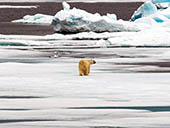 | Dispatch 3: Go with the Floe
During the night on our steam north, we began to enter ice floes which the icebreaker CCGS Louis S. St-Laurent effortlessly broke through. The ice damped the wave energy flattening the seas, and the relentlessly steady glide of the ship through the water began to gently shudder as it broke through the floes of ice. |
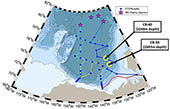 | Dispatch 4: Entering the Deep Waters
Sunday marked our 4th day steaming north in the Beaufort Sea aboard the CCGS Louis S. St-Laurent where we sailed open waters throughout the day. There was a 1-3’ sea, but that was too small to be felt by the powerful ship, and the lack of ice allowed steady progress to be made between stations. |
 | Dispatch 5: "Ice Blink" and Water Sky"
Monday as we continued to travel north across the Arctic deep water in open seas, an “ice blink” came into view. I learned today that “ice blink” is a sea term for locating ice foes on the horizon. If the opposite situation occurred where we would be traveling through ice and saw open water on the horizon, the term would instead be “water sky”. Traveling through sheets of ice rather than open water has an effect on the ride of the ship. Ice damps wind and wave energy so the water is calm and flat. As the ship crushes through the ice, you can hear it slide and push against the sides of the ship as the ship’s hull passes through. |
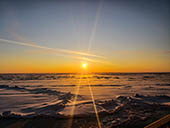 | Dispatch 6: Arctic CO2
Today, after sampling station PP7 late Monday night, we traveled west and to a lesser degree (pun intended!) north to cover stations CB-15, and CB-13 towards the center of the Canadian Basin. |
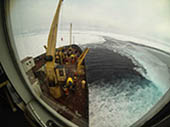 | Dispatch 7: The Ice Tethered Profiler (ITP)
Today was a particularly exciting day as we broke from our routine of CTD-rosette casts, plankton net tows, and XCTD launches as we continue to connect the dots between sampling stations across the beautiful Beaufort Sea. Don’t get me wrong, we still sampled the water column and collected jars of plankton, but we also deployed our first Ice Tethered Profiler for this year’s expedition! This deployment was in open water, which is unusual because ideally ITPs are deployed on the ice, so we had to work over the side of the ship utilizing the vessels forward A-frame and crane. |
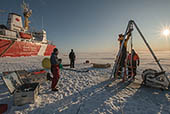 | Dispatch 8: The First Ice Station
On this sunny nearly windless day, we had a BIG day, as an ice floe suitable for establishing an ice station was located early in the morning. We discovered the floe earlier than expected which was great! Because this meant that instead of deploying a single Ice Tethered Profiler (ITP), the prototype Tethered Ocean Profiler (TOP) would also be deployed along with a Seasonal Ice Mass Balance buoy (SIMB). Opportunities like this do not always present themselves, so when they do, we capitalize on them! |
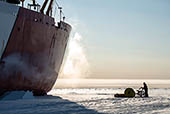 | Dispatch 9: Top of the World!...almost (81 degrees North)
It’s really cold out today! We awoke to -18° Celsius (-0.4° Fahrenheit) and a steady 10 knot breeze. I suppose it should not be a surprise because we are in the Arctic, and since yesterday have been between 80° and 81° North latitude, a little more than 9° of latitude below the North Pole. This is the farthest north I have personally ever been, and it is exciting! We are north of virtually all landmasses, except for Greenland, the Queen Elizabeth Islands and a few other smaller island clusters on the other side of the Arctic Ocean. This is also going to be the most northern extent of our Arctic expedition, and the ship worked hard to get us here! |
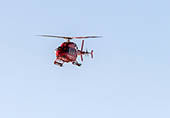 | Dispatch 10: The Whirly-Bird
We need to be flexible in this world of rigid ice. Today we were unable to make another Ice Tethered Profiler (ITP) deployment as planned. This was due to the slower progress we made steaming between stations as a result of heavy ice conditions. We really need to be at least 60 nautical miles from our last station, so we have to be patient and wait until tomorrow to make our deployment. |
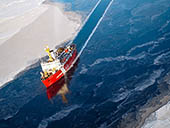 | Dispatch 11: Ice Station Three
Being adaptable doesn’t always mean we are trading down from an ideal situation, sometimes it allows us to get what we really want. In this case, being adaptable granted us a third ice station for our final Ice-Tethered Profiler (ITP) deployment. This deployment was originally planned to occur in open water and we now have the ideal situation where we will deploy the instrument in the ice, as it should be. |
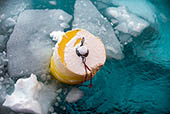 | Dispatch 12: Reverse Deployment (ITP Recovery)
Exiting the ice cover of the high Arctic, we crossed paths with an Ice Tethered Profiler (ITP) that had been deployed by this same research expedition one year prior. This ITP would have been left alone to continue collecting data for another year, except the profiler was no longer climbing its tether warranting a recovery if possible. Jeff O’Brien from the Woods Hole Oceanographic Institution (WHOI), while on the ship with us, sent the ITP we are trying to locate an updated “mission” file. |
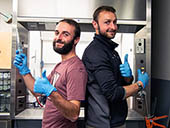 | Dispatch 13: The Microbial Arctic
Thomas Grevesse and I (Loïc Jacquemot) are PhD students hailing from Belgium and France. Thomas is studying at Concordia University in Montreal (Canada), and I am studying in Laval University in Québec city (Canada). Although we are coming from countries far removed from the Arctic, we are both interested in the same thing: microbial life in the Arctic. |
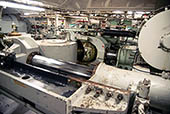 | Dispatch 14: In the Belly of the Beast (Engine Room Tour)
After spending two weeks aboard the heavy ice breaker CCGS Louis S. St-Laurent, it’s hard not to realize that the vessel is essentially an encapsulated civilization. This heavy icebreaker is a bit exceptional in its independence in that is has a helicopter, AUVs, and a few small vessels it can employ. |
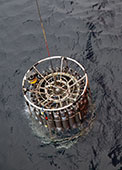 | Dispatch 15: The CTD Crew
Our Arctic expedition is two-thirds the way through and we are descending south from the high latitudes we had been sailing. Switch backing our way along the western side of the Beaufort Gyre we sample stations at each pivot in our journey. |
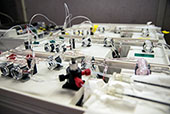 | Dispatch 16: Fuel for life in the Arctic
Tucked away in a cozy yet spacious laboratory, a robot-like machine feeds a network of shiny, glassy, clear tubing that coils and dives in and out of white boxes making clicks and hums. Sarah Ann from the Institute of Ocean Sciences (IOS) keeps a watchful eye and feeds the machine calibration solutions, samples, adjusts, adds new samples, and processes the data that are produced. |
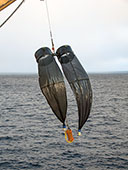 | Dispatch 17: Observing Ocean Temperature to Verify Satellite Measurements
In this cruise, Bingkun Luo (Ph.D. student, Rosenstiel School of Marine and Atmospheric Science, University of Miami) is a CTD watchstander. He prepares the CTD rosette (see dispatch 2) for deployment and is also responsible for safe operations with the vertical bongo net hauls at CTD stations |
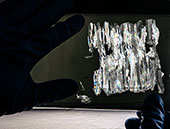 | Dispatch 18: Gradations of Sea Ice
Our steam south through the Arctic feels southern compared to where we had been as open waters and waves now surround us. The air is warmer than it had been, and overall it feels like we are now on a normal ship, in a normal watery ocean instead of a heavy icebreaker crushing and shuddering through plains of ice as far as the eye can see. |
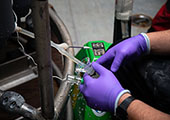 | Dispatch 19: 24 Hour Operations
Time at sea in the name of science is valuable, and in more ways than one. The world of research ships is a small one and access to a research ship is hard earned by the scientists writing the research proposals. You will find that the people that go on research ships have been on, or at least know about, virtually all of them. When a research vessel plans an expedition, the dates are strict, and the vessel fits in as much science as possible during its time at sea. There are always unpredictable things that can impact that time, the major one is weather. |
 | Dispatch 20: Personal "TED" Talks
For this expedition aboard the CCGS Louis S. St-Laurent there are 27 scientists from 10 institutions and universities hailing from three countries (Institute of Ocean Sciences, Canada; Woods Hole Oceanographic Institution, USA); Kitami Institute of Technology, Japan; Tokyo University of Marine Science and Technology, Japan; Universite de Sherbrooke, Canada; Concordia University, Canada; Laval University, Canada; Trent University, Canada; University of Miami, USA; University of Montana, USA). |
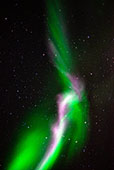 | Dispatch 21: End Science and Northern Lights
As abruptly as it started, it ended. Working like clockwork, it was announced today that we completed our last science station. I’m not going to lie, we were all eager to return home and to our loved ones, but it was a little bit bitter sweet. Over the course of three and a half weeks, we went from strangers on a ship to good acquaintances, and some would even say friends. Suddenly, we were packing up and groups continued to process the remainder of their samples. Over glasslike calm seas, we began our droning trek across ~500 miles to where it all began, Kugluktuk, Nunavut, Canada. |
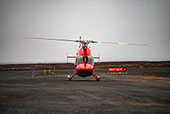 | Dispatch 22: Homeward Bound
Since early evening on Thursday, we have been anchored in Amundsen’s Gulf just outside Kugluktuk, Nunavut, Canada. Everyone has packed their laboratory equipment and secured it in the ship’s holds where it will be unloaded a month later when the CCGS Louis S. St-Laurent closes for the winter and returns to port in St. John’s Nova Scotia. Samples are preserved on ice and carefully packed for an airplane ride home with several of the scientists. |
























